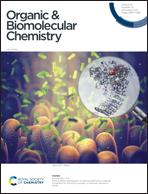Silicon compounds in carbon-11 radiochemistry: present use and future perspectives
Abstract
Positron emission tomography (PET) is a powerful functional imaging technique that requires the use of positron emitting nuclides. Carbon-11 (11C) radionuclide has several advantages related to the ubiquity of carbon atoms in biomolecules and the conservation of pharmacological properties of the molecule upon isotopic exchange of carbon-12 with carbon-11. However, due to the short half-life of 11C (20.4 minutes) and the low scale with which it is produced by the cyclotron (sub-nanomolar concentrations), quick, robust and chemospecific radiolabelling strategies are required to minimise activity loss during incorporation of the 11C nuclide into the final product. To address some of the constraints of working with 11C, the use of silicon-based chemistry for 11C-labelling was proposed as a rapid and effective route for radiopharmaceutical production due to the broad applicability and high efficiency showed in organic chemistry. In the past years several organic chemistry methodologies have been successfully applied to 11C-chemistry. In this short review, we examine silicon-based 11C-chemistry, with a particular emphasis on the radiotracers that have been successfully produced and potential improvements to further expand the applicability of silicon in radiochemistry.

- This article is part of the themed collection: Synthetic methodology in OBC


 Please wait while we load your content...
Please wait while we load your content...